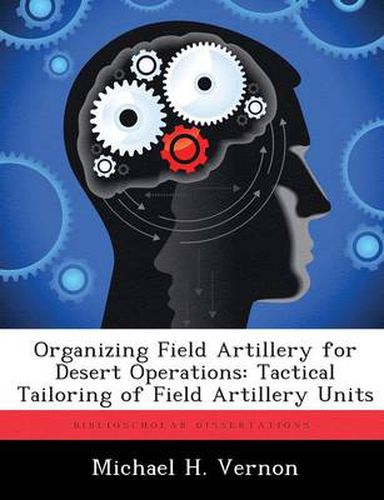Readings Newsletter
Become a Readings Member to make your shopping experience even easier.
Sign in or sign up for free!
You’re not far away from qualifying for FREE standard shipping within Australia
You’ve qualified for FREE standard shipping within Australia
The cart is loading…






This title is printed to order. This book may have been self-published. If so, we cannot guarantee the quality of the content. In the main most books will have gone through the editing process however some may not. We therefore suggest that you be aware of this before ordering this book. If in doubt check either the author or publisher’s details as we are unable to accept any returns unless they are faulty. Please contact us if you have any questions.
This study examines the organization for combat of U.S. Army field artillery units operating in a desert environment and determines the adequacy of current doctrine to insure effective field artillery support to U.S. Army heavy divisions conducting combat operations in the desert. An historical analysis of desert operations by the British and U.S. Army forces in North Africa in World War II is presented, and the lessons learned in these actions are examined in light of AirLand Battle doctrine. The study also discusses centralized and decentralized control of field artillery units and examines the differences presented on today’s battlefield by the meshing of offensive and defensive operations as exemplified by the AirLand Battle concept outlined in Field Manual 100-5, Operations. The study concludes that current doctrine is adequate to support organizing field artillery for combat operations on the AirLand Battlefield. The main problem is in the interpretation of current doctrine based on offensive or defensive operations. The author concludes by stating that to be successful, field artillery units must be organized to provide immediate close fires from field artillery battalions organic to maneuver brigades. The requirement to provide massed fires must be met by the field artillery brigades and battalions from the corps artillery
$9.00 standard shipping within Australia
FREE standard shipping within Australia for orders over $100.00
Express & International shipping calculated at checkout
This title is printed to order. This book may have been self-published. If so, we cannot guarantee the quality of the content. In the main most books will have gone through the editing process however some may not. We therefore suggest that you be aware of this before ordering this book. If in doubt check either the author or publisher’s details as we are unable to accept any returns unless they are faulty. Please contact us if you have any questions.
This study examines the organization for combat of U.S. Army field artillery units operating in a desert environment and determines the adequacy of current doctrine to insure effective field artillery support to U.S. Army heavy divisions conducting combat operations in the desert. An historical analysis of desert operations by the British and U.S. Army forces in North Africa in World War II is presented, and the lessons learned in these actions are examined in light of AirLand Battle doctrine. The study also discusses centralized and decentralized control of field artillery units and examines the differences presented on today’s battlefield by the meshing of offensive and defensive operations as exemplified by the AirLand Battle concept outlined in Field Manual 100-5, Operations. The study concludes that current doctrine is adequate to support organizing field artillery for combat operations on the AirLand Battlefield. The main problem is in the interpretation of current doctrine based on offensive or defensive operations. The author concludes by stating that to be successful, field artillery units must be organized to provide immediate close fires from field artillery battalions organic to maneuver brigades. The requirement to provide massed fires must be met by the field artillery brigades and battalions from the corps artillery